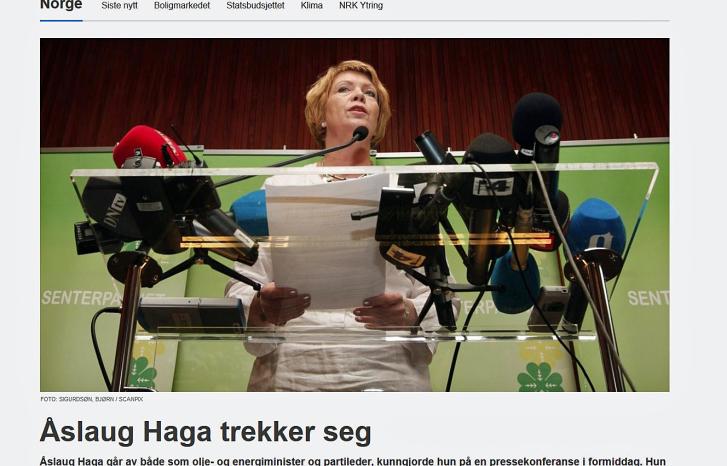Nearly half of all Norwegian journalists and editors have experienced bullying during the past five years, and this applies to almost as many men as women. Twenty-five per cent have been threatened, of whom the majority are men. Yet there are clear gender differences to be found in the online harassment.
“Women experience a more sexualised version of the harassment. They are called whore instead of idiot, and the bullying may evolve into rape threats,” says researcher at the Work Research Institute (AFI), Aina Landsverk Hagen.
She has recently published a book on online harassment and the freedom of speech, based on a research project in which she conducted in-depth interviews, as well as a survey among Norwegian journalists and editors.
A gendered phenomenon
According to the researcher, online harassment is a gendered phenomenon.
This does not mean that men are always the bullies and women the only ones who are being bullied, but there are clear gender differences in the harassment itself. Men are to a larger extent attacked for their opinions, whereas women receive comments related to their gender and appearance.
Depends on topic and line of work
The type of harassment also depends on the topic under discussion and the journalists’ line of work, for instance whether they work in television or within newspaper journalism.
“Male journalists who write news commentaries receive more harassment than their female colleagues, while women who work within television receive twice as much harassment as men in the same line of work,” she says.
Bullying consists of personal offences, insults or persecution by sources, interviewees or audience. It is often emotionally unpleasant but not necessarily criminal. Harassment is defined as repeated bullying over time. Threats may be both indirect and direct by way of retaliation or revenge for utterances.
A question of power
According to Hagen, her interviewees were particularly affected by the sexual threats, especially the first time they experienced serious threats.

“The harassment is not necessarily effective because of the bullying itself, but because of the shock you get when you realise that it has nothing to do with your opinions as a public debater. You’re hit from the side and you lose your footing,” says Hagen.
“Why do women receive so many sexual threats and harassments?”
“It is a question of power, pure and simple. It is not only men who are responsible for gendered harassment, and it is not always directed at women. It is about one group experiencing loss of status to another group. Bullying someone in a sexual manner is a highly effective master suppression technique. The bully is sure to hit his target. You have to be pretty thick-skinned not to be affected by it,” she says.
“Threats of rape is a sign of a status change between men and women. Women have acquired higher status as participants in the public debate. Some men obviously have a problem with that.”
“Stop calling them internet trolls”
Many people have argued that we have to find and expose those who post bullying messages in the comment sections online. According to Hagen, demonising the bullies by calling them internet trolls and referring to the comment sections as sewage is not the way to go.
“By calling the bullies trolls, we both dehumanise them and say that they have nothing to do with us. This is problematic, since it is phenomenon we have to deal with as a society,” says Hagen.
The angry, the crazy, and the dangerous
A better solution to the problem is, according to the researcher, to obtain what she calls harassment competence, such as learning how to distinguish between various forms of bullying, as her interviewees did. They distinguished between “the angry”, “the crazy”, and “the dangerous” bullies.
“’The angry’ are people you can respond to, and perhaps even make them understand that you’re a person who might get hurt by their utterances. Many experience that these bullies apologise when they are made aware of how their utterances are perceived. Harassment coming from ‘the crazy’ and ‘the dangerous’ had better be ignored, according to the journalists, since a reply often makes the bullying even worse,” she says.
Who are the bullies?
Little research has been carried out on those who bully and threat, but there are indications that a large majority are men between the age of 35 and 50. According to the affected journalists, the bullying is often connected to conspiracy theories and the insults related to racism and anti-feminism.
Hagen’s interviewees did not always know who was behind, but many had become good at interpreting the tone and the patterns in the messages. In this way, they managed to establish a relatively clear image of the senders.
See also: Boys more affected by gay insults
A democratic problem
Hagen doesn’t think the online bullying will disappear.
“Moderating the comment sections and preventing people from being anonymous may help a bit, but not much,” she says.
“Have we been too preoccupied with the bullies in the debate on online harassment instead of supporting those who are bullied?”
“The debate revolves to a large extent around the victims and the fact that they have to endure the harassment. This is in accordance with my data saying that the victims themselves are responsible for handling the harassment.”
According to the researcher, this is a democratic problem.
“The media loves to promote young female public debaters with minority background. But at the same time, these are the ones who experience most bullying. They have a triple burden to carry in terms of gender, age, and ethnic background. Many of them have no protection from an employer or the community, which makes it even more challenging.”
“The editorial offices must take responsibility”
According to Hagen, the media houses in general need to take more responsibility and improve their routines both around their own journalists and their freelance writers. Otherwise, the media will lose important public voices.
“Particularly young women must be prepared in order to prevent a massive shock when they start experiencing harassment.”
She thinks being part of a community is an important counter strategy when you’re being bullied.
“Having someone to talk to, perhaps someone who has experienced the same, may diminish the effect of the threats and the bullying. The community may help put the experiences into words and turn them into something less shameful.”
“Since the bullying is not likely to disappear, we have to take seriously that online harassment affects some journalists to such an extent that they might not be able to do their job properly or write about the topics close to their hearts.”
See also: Boys more exposed to relational bullying
Personal stories not enough
The debates on online public harassment are often based on personal individual accounts, such as the recent debate related to a Twitter campaign where women shared their everyday life experiences of sexual harassment. A similar debate took place in the wake of the Swedish documentary Män som netthatar kvinnor (“Men who hate women online”) in 2013.
“The personal accounts certainly have a function, and they push the debate a step further. But people often raise doubt about the stories’ trustworthiness. Surveys are important as a tool to confirm the scope of the harassment that is taking place,” says Hagen.
Undefined limits
She experienced a lot of interest in the figures from her survey on online bullying during her research.
“Only 17 per cent of the recipients responded to the survey. How representative are your figures?”
“The response rate is low, and this is a general problem with a lot of surveys nowadays. But the findings from this survey is nevertheless in line with previous surveys on working environment and bullying among journalists,” she says.
According to Hagen, the recent Twitter campaign is a clear evidence of the undefined limits between sexual harassment online and what many people experience in their everyday lives.
“These are not two distinct phenomena, and to many people the sexualised online harassment intensifies the recollection of previous experiences.”
Translated by Cathinka Dahl Hambro
- Among the respondents, nearly half of Norwegian journalists and editors have experienced harassment during the past five years. There were almost as many men as women among these.
- Twenty-five per cent have been threatened, of whom the majority are men.
- Young women are more affected than young men, and older men are more affected than older women.
- Female public debaters with minority background are exposed to both racist and sexist harassment. Moreover, they often lack protection from an employer.
- Twice as many women as men are threatened or harassed after TV appearances.
- The majority of the bullies are men; they bully both men and women, and they are between the age of 35 and 50.
(Source: Meningers mot - netthat og ytringsfrihet i Norge (“The Courage of Convictions – online harassment and freedom of speech in Norway”))
- Aina Landsverk Hagen is a social anthropologist and researcher at the Work Research Institute (AFI).
- Her book Meningers mot – netthat og ytringsfrihet i Norge (“The Courage of Convictions – online harassment and freedom of speech in Norway”) was recently published. The book is the result of a study based on interviews with Norwegian journalists and editors, as well as a survey carried out among all organised journalists and editors in the country.
- The survey was carried out in collaboration with the Norwegian Union of Journalists and the Association of Norwegian Editors.



